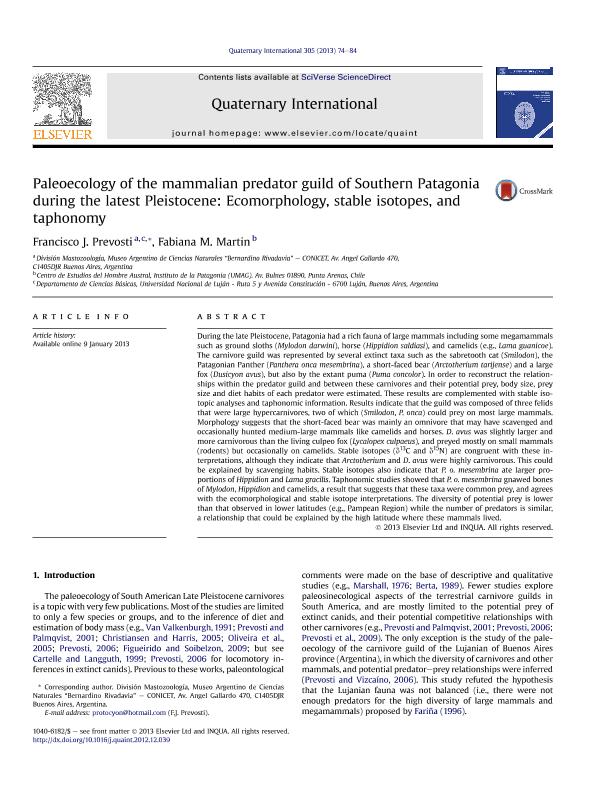Artículo
Paleoecology of the mammalian predator guild of Southern Patagonia during the latest Pleistocene: Ecomorphology, stable isotopes, and taphonomy
Fecha de publicación:
08/2013
Editorial:
Pergamon-Elsevier Science Ltd
Revista:
Quaternary International
ISSN:
1040-6182
Idioma:
Inglés
Tipo de recurso:
Artículo publicado
Clasificación temática:
Resumen
During the late Pleistocene, Patagonia had a rich fauna of large mammals including some megamammals such as ground sloths (Mylodon darwini), horse (Hippidion saldiasi), and camelids (e.g., Lama guanicoe). The carnivore guild was represented by several extinct taxa such as the sabretooth cat (Smilodon), the Patagonian Panther (Panthera onca mesembrina), a short-faced bear (Arctotherium tarijense) and a large fox (Dusicyon avus), but also by the extant puma (Puma concolor). In order to reconstruct the relationships within the predator guild and between these carnivores and their potential prey, body size, prey size and diet habits of each predator were estimated. These results are complemented with stable isotopic analyses and taphonomic information. Results indicate that the guild was composed of three felids that were large hypercarnivores, two of which (Smilodon, P. onca) could prey on most large mammals. Morphology suggests that the short-faced bear was mainly an omnivore that may have scavenged and occasionally hunted medium-large mammals like camelids and horses. D. avus was slightly larger and more carnivorous than the living culpeo fox (Lycalopex culpaeus), and preyed mostly on small mammals (rodents) but occasionally on camelids. Stable isotopes (δ13C and δ15N) are congruent with these interpretations, although they indicate that Arctotherium and D. avus were highly carnivorous. This could be explained by scavenging habits. Stable isotopes also indicate that P. o. mesembrina ate larger proportions of Hippidion and Lama gracilis. Taphonomic studies showed that P. o. mensembrina gnawed bones of Mylodon, Hippidion and camelids, a result that suggests that these taxa were common prey, and agrees with the ecomorphological and stable isotope interpretations. The diversity of potential prey is lower than that observed in lower latitudes (e.g., Pampean Region) while the number of predators is similar, a relationship that could be explained by the high latitude where these mammals lived.
Palabras clave:
Carnivora
,
Paleoecología
,
Patagonia
,
Cuaternario
Archivos asociados
Licencia
Identificadores
Colecciones
Articulos(MACNBR)
Articulos de MUSEO ARG.DE CS.NAT "BERNARDINO RIVADAVIA"
Articulos de MUSEO ARG.DE CS.NAT "BERNARDINO RIVADAVIA"
Citación
Prevosti, Francisco Juan; Martin, Fabiana Maria; Paleoecology of the mammalian predator guild of Southern Patagonia during the latest Pleistocene: Ecomorphology, stable isotopes, and taphonomy; Pergamon-Elsevier Science Ltd; Quaternary International; 305; 8-2013; 74-84
Compartir
Altmétricas




